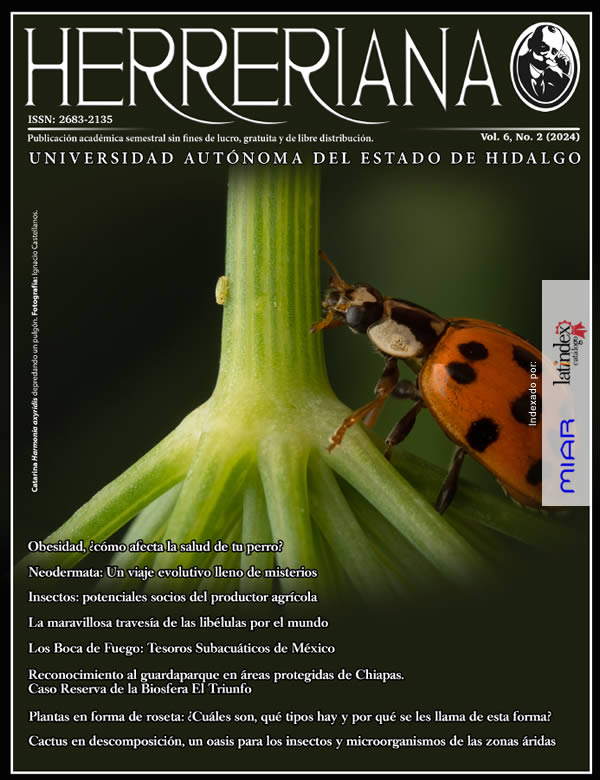The wonderful journey of dragonflies around the world
Abstract
Migration is distinguished by long trips and movements with the objective of reproduction, search for breeding places, search for shelters among other places. A large part of the insect species has been this type of behavior; the effect has been to protect migratory species and protect the habitats and components of biodiversity found on migratory routes.
Migration in dragonflies is of most importance since it can explain the distribution of certain species, in addition to helping us to know beneficial aspects for conservation and to know the potential of freshwater bodies and the biodiversity that are in them, therefore, it is important to recognize the value of the study in these aspects of migration and dispersion.
Downloads
References
Anderson, R. C. (2009). Do dragonflies migrate across the western Indian Ocean? Journal of tropical Ecology, 25(4), 347-358.
Brenner, L. (2006). Áreas naturales protegidas y ecoturismo: el caso de la Reserva de la Biosfera Mariposa Monarca, México. Relaciones. Estudios de historia y sociedad, 27(105), 237-265.
Corbet, P. S. (1999). Dragonflies. Behavior and ecology of Odonata. Comstock Publishers Associates. New York, 829 p.
González-Soriano, E. (1993). Odonata de México: Situación actual y perspectivas de estudio. Revista de la Sociedad Mexicana de Historia Natural, 44, 291‒302.
González-Soriano, E. y Novelo-Gutiérrez, R. (2014). Biodiversidad de Odonata en México. Revista Mexicana de Biodiversidad, Suplemento 85, 243-251.
Hobson, K. A., Anderson, R. C., Soto, D. X. y Wassenaar, L. I. (2012). Isotopic evidence that dragonflies (Pantala flavescens) migrating through the Maldives come from the northern Indian subcontinent, PloS one, 7(12), e52594.
May, M. L. y Matthews, J. H. (2008). Migration in Odonata: a case study of Anax junius. En: Córdoba-Aguilar, A. (Eds), Dragonflies, model organisms for ecological and evolutionary research (pp. 63-77). Oxford University Press, Oxford.
Méndez-Arreola, R. (2022). Entre maestros y educadores ambientales: construcción colectiva de actividades de aprendizaje ambiental sobre la migración de la mariposa monarca en México. Revista del Instituto de Investigaciones en Educación, 13(17), 141-160.
Kalkman V.J., Clausnitzer V., Dijkstra K.D.B., Orr A.G., Paulson D.R. y van Tol J. (2008). Global diversity of dragonflies (Odonata) in freshwater. Hidrobiologia, 595: 351-363.
Oliveira-Junior J.M.B., Shimano Y., Gardner T.A., Hughes R.M., Marco-Júnior P. y Juen L. (2015). Neotropical dragonflies (Insecta: Odonata) as indicators of ecological condition of small streams in the eastern Amazon. Austral Ecology, 40: 733-744.
Paulson, D. R., Abbott, J., May, M., Jones, C., Blackburn, M., y Mazzacano, C. (2014). Guía de identificación para las libélulas migratorias. Migratory Dragonfly Partnership, La Alianza para las Libélulas Migratorias. http://www.migratorydragonflypartnership.org/uploads/_ROOT/File/MDP-field_guide_Spanish.pdf.
Paulson D.R., Schorr M. y Deliry C. (2024). World Odonata List. Slater Museum of Natural History, University of Puget Sound. Tacoma, WA. https://www2.pugetsound.edu/academics/academic-resources/slater-museum/biodiversity-resources/dragonflies/mexican-odonata/
Ramírez, A. 2010. (Capítulo 5). Odonata. Revista de Biología Tropical 58, 97-136.
Sánchez, A., Pérez, J., Jiménez, E., y Tovar, C. (2009). Los odonatos de Extremadura. Consejería de Industria, Energía y Medio Ambiente, Junta de Extremadura, Mérida, 337 p.
Suárez‐Tovar, C. M. y Sarmiento, C. E. (2016). Beyond the wing planform: morphological differentiation between migratory and nonmigratory dragonfly species. Journal of Evolutionary Biology, 29(4), 690-703.
Copyright (c) 2024 Josue Silva, Ana Paola Martínez-Falcón

This work is licensed under a Creative Commons Attribution-NonCommercial-NoDerivatives 4.0 International License.










